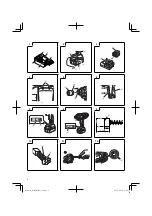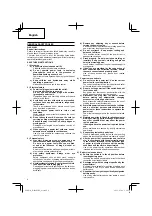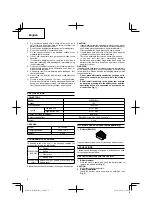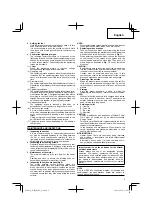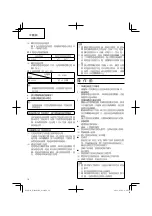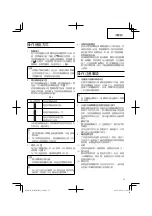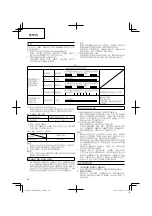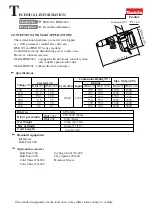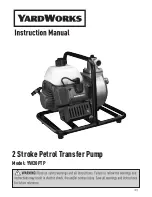
English
7
CHARGING
Before
using
the
power
tool,
charge
the
battery
as
follows.
1. Connect the charger’s power cord to a receptacle.
When
the
power
cord
is
connected,
the
charger’s
pilot
lamp
will
blink
in
red.
(At
1-second
intervals)
2. Insert the battery into the charger.
Firmly
insert
the
battery
into
the
charger
until
the
line
is
visible,
as
shown
in
Fig. 3
,
4
.
3. Charging.
When
inserting
a
battery
in
the
charger,
charging
will
commence
and
the
pilot
lamp
will
light
continuously
in
red.
When
the
battery
becomes
fully
recharged,
the
pilot
lamp
will
blink
in
red.
(At
1-second
intervals)
(See
Table 1
)
(1)
Pilot
lamp
indication
The
indications
of
the
pilot
lamp
will
be
as
shown
in
Table 1
,
according
to
the
condition
of
the
charger
or
the
rechargeable
battery.
Table 1
Indications
of
the
pilot
lamp
The
pilot
lamp
lights
or
blinks
in
red.
Before
charging
Blinks
Lights
for
0.5
seconds.
Does
not
light
for
0.5
seconds.
(o
ff
for
0.5
seconds)
While
charging
Lights
Lights
continuously
Charging
complete
Blinks
Lights
for
0.5
seconds.
Does
not
light
for
0.5
seconds.
(o
ff
for
0.5
seconds)
Charging
impossible Flickers
Lights
for
0.1
seconds.
Does
not
light
for
0.1
seconds.
(o
ff
for
0.1
seconds)
Malfunction
in
the
battery
or
the
charger
The
pilot
lamp
lights
in
green.
Overheat
standby
Lights
Lights
continuously
Battery
overheated.
Unable
to
charge.
(Charging
will
commence
when
battery
cools)
(2)
Regarding
the
temperatures
of
the
rechargeable
battery
The
temperatures
for
rechargeable
batteries
are
as
shown
in
Table 2
,
and
batteries
that
have
become
hot
should
be
cooled
for
a
while
before
being
recharged.
Table 2
Recharging
ranges
of
batteries
Rechargeable
batteries
Temperatures
at
which
the
battery
can
be
recharged
BSL1830
0°C
–
50°C
(3)
Regarding
recharging
time
Depending
on
the
combination
of
the
charger
and
batteries,
the
charging
time
will
become
as
shown
in
Table 3
.
Table 3
Charging
time
(At
20°C)
Charger
Battery
UC18YRSL
BSL1830
Approx.
45
min.
NOTE:
The
charging
time
may
vary
according
to
temperature
and
power
source
voltage.
4. Disconnect the charger’s power cord from the
receptacle
5. Hold the charger
fi
rmly and pull out the battery
NOTE:
After
charging,
pull
out
batteries
from
the
charger
fi
rst,
and
then
keep
the
batteries
properly.
Regarding electric discharge in case of new batteries,
etc.
As
the
internal
chemical
substance
of
new
batteries
and
batteries
that
have
not
been
used
for
an
extended
period
is
not
activated,
the
electric
discharge
might
be
low
when
using
them
the
fi
rst
and
second
time.
This
is
a
temporary
phenomenon,
and
normal
time
required
for
recharging
will
be
restored
by
recharging
the
batteries
2
–
3
times.
How to make the batteries perform longer.
(1)
Recharge
the
batteries
before
they
become
completely
exhausted.
When
you
feel
that
the
power
of
the
tool
becomes
weaker,
stop
using
the
tool
and
recharge
its
battery.
If
you
continue
to
use
the
tool
and
exhaust
the
electric
current,
the
battery
may
be
damaged
and
its
life
will
become
shorter.
(2)
Avoid
recharging
at
high
temperatures.
A
rechargeable
battery
will
be
hot
immediately
after
use.
If
such
a
battery
is
recharged
immediately
after
use,
its
internal
chemical
substance
will
deteriorate,
and
the
battery
life
will
be
shortened.
Leave
the
battery
and
recharge
it
after
it
has
cooled
for
a
while.
CAUTION
○
When
the
battery
charger
has
been
continuosly
used,
the
battery
charger
will
be
heated,
thus
constituting
the
cause
of
the
failures.
Once
the
charging
has
been
completed,
give
15
minutes
rest
until
the
next
charging.
○
If
the
battery
is
recharged
when
it
is
warm
due
to
battery
use
or
exposure
to
sunlight,
the
pilot
lamp
map
light
in
green.
The
battery
will
not
be
recharged.
In
such
a
case,
let
the
battery
cool
before
charging.
000Book̲WR18DSHL̲Ara.indb 7
000Book̲WR18DSHL̲Ara.indb 7
2012/07/16 9:20:58
2012/07/16 9:20:58


